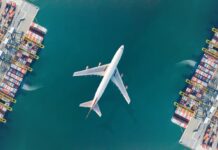

China’s air cargo industry, already epic in its scale, brings with it changes in where business is being done as well as offering a new model for how that business can be done, writes Michael Mackey.
There can even in its early stages be no doubting the scale of the air cargo sector or the growth it enjoyed in 2017.
“(D)ata from IATA’s Cargo Account Settlement Systems (CASS) volumes point to an increase in the order of 20 per cent year-on-year for both imports and exports to/from China in 2017, but this data does not cover 100 per cent of the market,” IATA’s chief economist Brian Pearce told Air Cargo Week.
A number of factors are driving this industrial upgrading, strong consumer spending and the recovery of world trade and, of course, e-Commerce.
Wide-ranging though the goods moved are, the majority is high-tech material such as computers, mobile phones, automotive and auto parts and fashion such as clothing and apparel sectors, Panalpina’s head of Air Freight for Greater China Jack Liu told Air Cargo Week. Silicon is also a growing market logging up increases of 10 per cent.
Not there can be no forgetting or getting away from the importance that e-Commerce and its explosion has in China.
Worth $1.14 trillion in 2017 the estimate is this year China’s cross-border e-Commerce will reach $1.49 trillion, Shenzhen Cross Border E-commerce Association deputy executive president William Zhang said at a recent conference in Bangkok to the sound of jaws hitting the floor.
As if that wasn’t enough, Zhang also made two other points. These figures are on the low side as a lot of the China’s e-Commerce is moved through Hong Kong. Furthermore, by 2020 the expectation is over a third of China’s total trade will be e-Commerce, Zhang added.
All this is bringing with it changes not so much in where business is done, although some of it is surprising, but in how it is done.
“Chinese investment in Africa, has contributed to the development of new capacity and trade flows between Asia-Africa. And, export order books amongst the Asia-Pacific key exporting nations, including China, are at elevated levels, pointing to air freight growth remaining robust in the first part of this year,” says IATA’s Pearce.
Traditionally volumes moved through Hong Kong, from the Pearl River Delta, Shanghai from the Yangtze River Delta economic zone as well as Zhengzhou, Beijing and Tianjin for northern China, Panalpina’s Liu said. That model is holding but with variations.
“Hong Kong, Shanghai and Zhengzhou, all grew tremendously last year, but Zhengzhou grew exceptionally fast considering the low base it had a few years back when compared to the traditional airfreight hubs such as Hong Kong and Shanghai,” Liu told Air Cargo Week.
“However, with the high-demand situation experienced last year, alternative routings are being explored by airlines and charter operators, not only in tier one cities such as Shenzhen, Guangzhou, but also in tier two and three cities such as Ningbo, Wuxi, Nanjing, Wuhan, Jinan, Hefei, Kunming.”
Corroboration for this much of this comes from Changi in Singapore, a noted air cargo hub, whose largest air cargo market turns out to be China, according Air Hub Development Changi Airport Group managing director Lim Ching Kiat.
In 2017, Changi’s China trade grew 15 per cent as imports and exports grew 19 per cent and 12 per cent respectively. Due to the higher proportion of passenger services with China, a majority of the cargo is currently being transported belly hold.
Changi Airport is now connected to 34 cities in China with over 340 weekly services. Compared to 2013, this is an increase of 10 cities and about 60 weekly services – and there is more to come.
“Intensifying our air connectivity, both increasing frequencies and establishing new city links, with China has always been our key priority. In the coming year, we hope to establish links to other provincial capitals such as Taiyuan, Hefei and Nanchang,” he added.
There is in all this one problem: not yet major but looming, infrastructure. Whilst there might be some leeway to be had in the growth of secondary airports, with Wuhan and Xian both being cited regularly there are concerns, about the constraints at airports especially at the hubs.
“Currently the challenge is limited slots,” said Nippon Cargo Airlines head of marketing/business strategy Hiruyuki Homma, who with others also noted another upcoming worry: the lack of the right type planes. Limited large freighter production against the dramatic growth of e-commerce could squeeze the market in future they argue.
What mitigates the infrastructure problem is government support which among more thoughtful and forward-looking industry sources is a worry in itself.
China is building a lot of infrastructure at the moment to boost the country’s central and western regions.
That building tends to be where government wants and maybe not where the industry needs. Some have also questioned the sustainability of government support.
“Government policy can change any time,” said one source before asking rhetorically “how long will subsidies last?”













